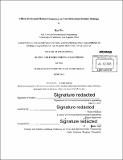| dc.contributor.advisor | Pierre Ghisbain. | en_US |
| dc.contributor.author | Han, Wu, M. Eng. Massachusetts Institute of Technology | en_US |
| dc.contributor.other | Massachusetts Institute of Technology. Department of Civil and Environmental Engineering. | en_US |
| dc.date.accessioned | 2015-10-30T19:01:41Z | |
| dc.date.available | 2015-10-30T19:01:41Z | |
| dc.date.copyright | 2015 | en_US |
| dc.date.issued | 2015 | en_US |
| dc.identifier.uri | http://hdl.handle.net/1721.1/99622 | |
| dc.description | Thesis: M. Eng., Massachusetts Institute of Technology, Department of Civil and Environmental Engineering, 2015. | en_US |
| dc.description | Cataloged from PDF version of thesis. | en_US |
| dc.description | Includes bibliographical references (page 88). | en_US |
| dc.description.abstract | The need for economic consideration in structural design triggered the emergence of performance-based design to minimize material waste while achieving better performance. The displacement measurements of structures are significant to structural damage evaluation, and most seismic design methods consider the effect of peak ground acceleration, while the frequency content of seismic activities remains largely unexplored. In order to better understand the impact of low magnitude seismic activities on non-structural damage, we develop an assessment method for a specific site by comparing structural response with frequency content analysis on corresponding seismic activities. A method of analyzing frequency content of seismic activities at San Francisco is presented. By computing Discrete Fourier Transforms, time history seismic data is transformed from time domain to frequency domain. We apply structural response analysis on a representative residential/office/mixed-use building to evaluate seismic performance. We scale earthquakes with respect to the natural frequency of the target structure, and structural response simulations are performed based on scaled earthquakes. We utilize linear analysis in structural response simulations with constant damping ratio. The applicability of linear analysis as well as varying damping ratio requires further justification. A comparison between frequency content analysis and structural response is presented. The frequency content analysis provides an amplitude distribution for each seismic activity, and the magnitude of structural response is influenced by the amplitude distribution for corresponding seismic activities. | en_US |
| dc.description.statementofresponsibility | by Wu Han. | en_US |
| dc.format.extent | 88 pages | en_US |
| dc.language.iso | eng | en_US |
| dc.publisher | Massachusetts Institute of Technology | en_US |
| dc.rights | M.I.T. theses are protected by copyright. They may be viewed from this source for any purpose, but reproduction or distribution in any format is prohibited without written permission. See provided URL for inquiries about permission. | en_US |
| dc.rights.uri | http://dspace.mit.edu/handle/1721.1/7582 | en_US |
| dc.subject | Civil and Environmental Engineering. | en_US |
| dc.title | Effect of ground motion frequency on non-structural seismic damage | en_US |
| dc.type | Thesis | en_US |
| dc.description.degree | M. Eng. | en_US |
| dc.contributor.department | Massachusetts Institute of Technology. Department of Civil and Environmental Engineering | |
| dc.identifier.oclc | 926712363 | en_US |
